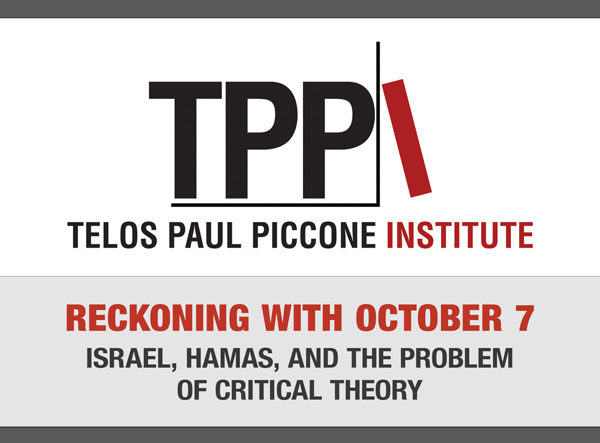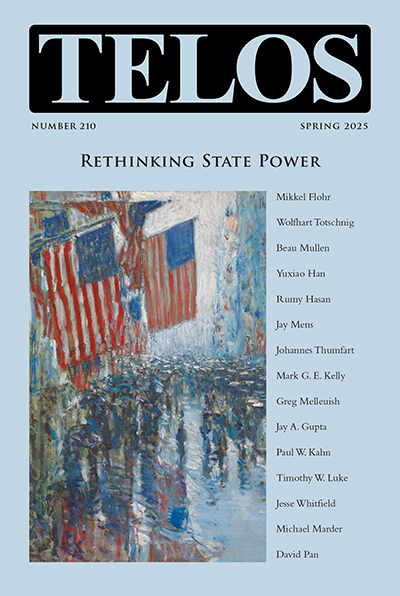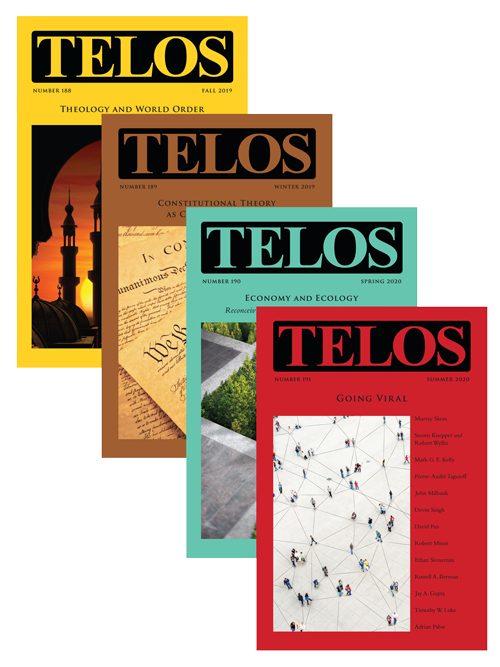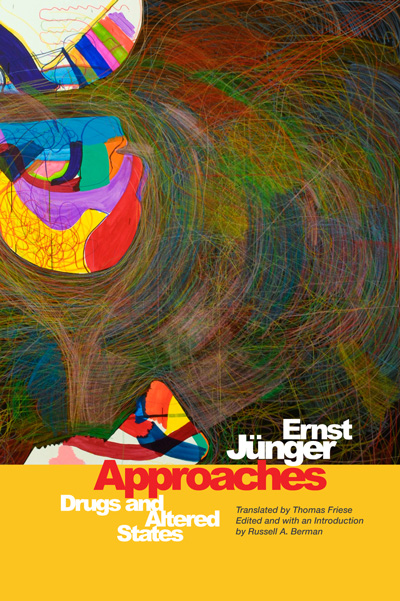By Julius Bielek · Tuesday, April 30, 2024 The following essay is part of a special series of responses to recent events centered, for now, at Columbia University, and extending beyond its confines to include the wider array of societal problems that the disorder there symptomatizes. For details, see Gabriel Noah Brahm, “From Palestine Avenue to Morningside Heights.”—Gabriel Noah Brahm, Director of the Telos-Paul Piccone Institute’s Israel initiative  When a student at the well-known Berlin art school Universität der Künste (UdK) used psychoanalytic terms to question her teacher’s assertion that we should listen to the “trees talking” more, she was attacked for her “colonial racist thinking,” using concepts of the white man, Sigmund Freud, to delegitimize “indigenous knowledge.” When a student at the well-known Berlin art school Universität der Künste (UdK) used psychoanalytic terms to question her teacher’s assertion that we should listen to the “trees talking” more, she was attacked for her “colonial racist thinking,” using concepts of the white man, Sigmund Freud, to delegitimize “indigenous knowledge.”
A few weeks later, UdK students protested against Israel fighting back against the insurgents of October 7th, with banners that read “Stop the Genocide” or “It’s Not Complicated.” Dressed in all black, wearing black corona masks, and holding up red hands, supposedly meant to symbolize the blood that was on Germany’s hands, or bingo!, it’s “indigenous custom.” The president of the university tried to intervene, but the protestors shouted him down.
Such protests marked the onset of a series of disturbances at Berlin universities following October 7th. These reached a culminating point when a Jewish Freie Universität student, Lahav Shapira—a known critic of the pro-Palestine protests and himself a descendant of one of the Israeli athletes murdered in the 1972 Munich massacre—was brutally attacked by an anti-Zionist Muslim student who recognized Shapira as he was exiting a bar. At first this made headlines in Germany—not because a Jew had been hospitalized after an antisemitic attack, but because he is the brother of the well-known comedian Shahak Shapira.
Continue reading →
By Andrei S. Markovits · Monday, April 29, 2024 The following essay is part of a special series of responses to recent events centered, for now, at Columbia University, and extending beyond its confines to include the wider array of societal problems that the disorder there symptomatizes. For details, see Gabriel Noah Brahm, “From Palestine Avenue to Morningside Heights.”—Gabriel Noah Brahm, Director of the Telos-Paul Piccone Institute’s Israel initiative The following text is an expanded English-language version of the German article “Palestine Avenue,” published in Konkret 2/24, pp. 38–39.
 I remember it well. It was in the spring of 1987 when I commenced my lecture in Osnabrück on the German left with these remarks: “So that we understand each other: Regardless of my heavy criticisms and profound objections to many facets of its current affairs, I fully accept the existence of the Federal Republic of Germany and do not want its destruction!” People looked at me as if I had lost my mind! I remember it well. It was in the spring of 1987 when I commenced my lecture in Osnabrück on the German left with these remarks: “So that we understand each other: Regardless of my heavy criticisms and profound objections to many facets of its current affairs, I fully accept the existence of the Federal Republic of Germany and do not want its destruction!” People looked at me as if I had lost my mind!
But I said: “Such a fundamental statement of situating the speaker’s normative orientation is de rigueur at the beginning of every discussion involving anything relating to Israeli politics, society, and culture. The very existence of the country has simply never been accepted as a matter of course. Thus, it must be affirmed in every case.” Nothing has changed in the ensuing forty years. None of the 193 UN members must experience this every day in the most varied discussions all over the world, be it about their politics or society, culture or food, language or habits. None of these items are legitimate in Israel’s case. Just witness the bitter conflicts involving “inauthentic” Israeli food and its alleged appropriation of “authentic” Palestinian food, conveniently forgetting that all foods everywhere are appropriations and amalgams of various cultures. The more appropriation, the better, I would argue. Look at how much better food in Germany has become by appropriating Italian, Turkish, and Greek food.
Following violent conflicts, hostile neighbors may not accept each other’s post-conflict existence for a while, but none have had the temporal length (seventy-five years and counting) or the spatial dimension (reaching across the globe, far from the respective country’s borders) that pertains in the case of Israel. Serbia may not accept the existence of Kosovo, nor Georgia that of Abkhazia, but either’s alleged nonexistence does not matter in a discussion about them in Nigeria or Thailand. What makes the Israeli situation so unique is that this ubiquitous unacceptance exists in all corners of the globe and among the most varied publics. Making it more pernicious still is that this unacceptance is perhaps more prominent in spaces of civil society than in those of governments. Even in the case of apartheid-ruled South Africa from the 1960s to the 1990s (with which Israel is always associated), it was South Africa’s apartheid regime that was anathema, not the country’s existence per se. One did not have to begin any discussion about South African apartheid by stating that one did not desire the destruction of South Africa as a country.
Continue reading →
By Cary Nelson · Friday, April 26, 2024 The following essay is part of a special series of responses to recent events centered, for now, at Columbia University, and extending beyond its confines to include the wider array of societal problems that the disorder there symptomatizes. For details, see Gabriel Noah Brahm, “From Palestine Avenue to Morningside Heights.”—Gabriel Noah Brahm, Director of the Telos-Paul Piccone Institute’s Israel initiative Introduction
 Every day, it seems, we advance into darkness we have not known before. It is not a journey we have sought out or chosen for ourselves. We are swept along by a current of malice that can only be avoided if we hide from the news. The spectacle of a mass antizionist and antisemitic “Gaza Solidarity Encampment” on Columbia University’s central quad and elsewhere has structural predecessors, to be sure, like the Occupy Wall Street movement, but parallels with mass antisemitism require comparison with earlier historical moments. The Occupy Wall Street movement was notably accompanied by a substantial body of theoretical work, whereas the Columbia occupation is supported by little more than a Manichean view of a world divided between oppressor and oppressed peoples. The students promise to remain until Columbia meets their divestment demands—which presumably means they will be in their tents for a very long time indeed, since for governing boards to cede their investment authority to mob action means giving up their other responsibilities as well. Every day, it seems, we advance into darkness we have not known before. It is not a journey we have sought out or chosen for ourselves. We are swept along by a current of malice that can only be avoided if we hide from the news. The spectacle of a mass antizionist and antisemitic “Gaza Solidarity Encampment” on Columbia University’s central quad and elsewhere has structural predecessors, to be sure, like the Occupy Wall Street movement, but parallels with mass antisemitism require comparison with earlier historical moments. The Occupy Wall Street movement was notably accompanied by a substantial body of theoretical work, whereas the Columbia occupation is supported by little more than a Manichean view of a world divided between oppressor and oppressed peoples. The students promise to remain until Columbia meets their divestment demands—which presumably means they will be in their tents for a very long time indeed, since for governing boards to cede their investment authority to mob action means giving up their other responsibilities as well.
Continue reading →
By David Pan · Wednesday, April 24, 2024 The following essay is part of a special series of responses to recent events centered, for now, at Columbia University, and extending beyond its confines to include the wider array of societal problems that the disorder there symptomatizes. For details, see Gabriel Noah Brahm, “From Palestine Avenue to Morningside Heights.”—Gabriel Noah Brahm, Director of the Telos-Paul Piccone Institute’s Israel initiative  Columbia University president Nemat Shafik’s recent testimony to Congress indicates an important shift in our conception of academic freedom. While affirming the legal principle of free speech, she clearly accepted limits on academic freedom by stating that calls for genocide have no place at the university. Since at least one issue would disqualify someone from participating in Columbia’s educational project, she opens up the question of the limits of academic freedom and the duty of a university to enforce such limits through decisions on hiring and dismissal of faculty as well as suspension of students. While the American Association of University Professors seeks to criticize such restrictions on academic freedom, its 1940 statement on academic freedom stipulates that “[i]nstitutions of higher education are conducted for the common good and not to further the interest of either the individual teacher or the institution as a whole.” The congressional hearings have demonstrated that the common good may require restrictions on academic freedom, and such restrictions indeed are already part of the way universities see their mission. Columbia University president Nemat Shafik’s recent testimony to Congress indicates an important shift in our conception of academic freedom. While affirming the legal principle of free speech, she clearly accepted limits on academic freedom by stating that calls for genocide have no place at the university. Since at least one issue would disqualify someone from participating in Columbia’s educational project, she opens up the question of the limits of academic freedom and the duty of a university to enforce such limits through decisions on hiring and dismissal of faculty as well as suspension of students. While the American Association of University Professors seeks to criticize such restrictions on academic freedom, its 1940 statement on academic freedom stipulates that “[i]nstitutions of higher education are conducted for the common good and not to further the interest of either the individual teacher or the institution as a whole.” The congressional hearings have demonstrated that the common good may require restrictions on academic freedom, and such restrictions indeed are already part of the way universities see their mission.
Continue reading →
By Gabriel Noah Brahm · Tuesday, April 23, 2024  A virulent, novel strain of anti-Zionist antisemitism is loose on the American campus. A virulent, novel strain of anti-Zionist antisemitism is loose on the American campus.
In the wake of October 7, 2023’s barbaric terrorist assault on southern Israeli kibbutzim, a rave party, and a small military base, the Jewish state has been denounced loudly by extremists. As a consequence, Jewish students and faculty in the United States find themselves as unwelcome in the quad or the classroom as a troop of uniformed IDF soldiers. For pro-Hamas demonstrators, as for the terror organization itself, there is essentially no difference.
Apparently the result of a lab leak containing intellectual materials gleaned from various “studies” programs, where experimentation with conceptual “gain of function research” had gone on in relative obscurity for some time (Gender Studies, Middle East Studies, LGBTQ Studies, Critical Legal Studies), a potent “new-new antisemitism,” as it’s being called, is on the loose, spiked with heavy doses of esoteric and markedly volatile ideologemes. “Intersectionality,” in its more dubious applications, reduces all moral and political questions to matters of “oppressor” and “oppressed.” “Critical race theory” brands Jews not only as “white” (a term used on campus to mean “structurally racist”) but “hyper-white” (the whitest, therefore most racist of all). Theories of “settler colonialism” misrepresent Jews as colonizers in their own indigenous lands and the State of Israel as somehow illegitimate, despite its rather unique birth certificate, bestowed by the United Nations itself in 1947. Moreover, what the proponents of all these ideologies have in common is that they point to Jews and Israel as uniquely blameworthy personifications of all the “evils” attributed to the West, historically, by its occidentalist critics.
Continue reading →
 The fifth webinar in the Telos-Paul Piccone Institute’s yearlong series reckoning with the response to October 7 will take place on Tuesday, May 7, 2024, at noon Eastern Time. The fifth webinar in the Telos-Paul Piccone Institute’s yearlong series reckoning with the response to October 7 will take place on Tuesday, May 7, 2024, at noon Eastern Time.
Click here to register for the event.
All subsequent panels are likewise scheduled for noon Eastern Time on the seventh day of each month. Panels will run between 90 to 120 minutes, followed by a colloquy among the panelists and audience Q&A.
Our fifth webinar is titled “Our Troubled Institutions: The End(s) of Higher Education, Post-Journalism, and Antisemitism after October 7.” The panelists are Russell A. Berman, who will speak on “Higher Ed after October 7: Drain the Swamp,” and Gadi Taub, who will address the topic of “Post-Journalism: How the Press Replaced an Ethos of Honest Reporting with an Ethos of Political Activism, and How This Colors Public Debate about October 7.” Our respondent is Paulina Neuding.
Continue reading →
|
|
 When a student at the well-known Berlin art school Universität der Künste (UdK) used psychoanalytic terms to question her teacher’s assertion that we should listen to the “trees talking” more, she was attacked for her “colonial racist thinking,” using concepts of the white man, Sigmund Freud, to delegitimize “indigenous knowledge.”
When a student at the well-known Berlin art school Universität der Künste (UdK) used psychoanalytic terms to question her teacher’s assertion that we should listen to the “trees talking” more, she was attacked for her “colonial racist thinking,” using concepts of the white man, Sigmund Freud, to delegitimize “indigenous knowledge.” 

